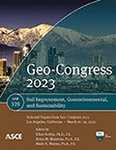Biochar in Quick Clay Stabilization: Reducing Carbon Footprint and Improving Shear Strength
Publication: Geo-Congress 2023
ABSTRACT
Alternative materials like biochar can be utilized to improve soil strength, while reducing the carbon footprint of soil stabilization through carbon sequestration. This paper studied the effect of various biochar/cement dosages on strength and stiffness of quick clay. Laboratory tests revealed that biochar quantities as low as 50 kg/m3 resulted in undrained shear strength, cu, values (i.e., cu = 2.8 kPa) greater than the 0.5 kPa threshold for remolded quick clay. Biochar amendment also enhanced cu of cement-stabilized quick clay. For example, the cu of quick clay samples stabilized with 25, 50, or 100 kg/m3 of cement increased between 20% and 40% when amending with 100 kg/m3 of biochar. Depending on the cement quantity, an optimum biochar dosage of 75–125 kg/m3 was identified. A sustainability assessment indicated that biochar amendments >30% of the used cement rendered the soil stabilization process carbon neutral. The current cost of biochar was, however, found to be greater than its benefits for soil stabilization. This may change in future because of higher carbon prices or lower biochar manufacturing costs.
Get full access to this article
View all available purchase options and get full access to this chapter.
REFERENCES
Åhnberg, H. (2006). Strength of Stabilized Soil-A Laboratory Study on Clays and Organic Soils Stabilized with different Types of Binder. PhD dissertation. Lund University, Sweden.
Bache, B. K., Wiersholm, P., Paniagua, P., and Emdal, A. (2022). 2Effect of Temperature on the Strength of Lime–Cement Stabilized Norwegian Clays.” J. Geot. Geoenv. Eng., 148(3).
Börgesson, L. (1981). Shear strength of inorganic silty soils. Proc. 10th ICSMFE, Stockholm, Sweden, 1, 567–57.
Hov, S., Paniagua, P., Sætre, C., Rueslåtten, H., Størdal, I., Mengede, M., and Mevik, C. (2022). Lime-cement stabilisation of Trondheim clays and its impact on carbon dioxide emissions. Soils and Foundations, 62(3), 101162.
IPCC (The Intergovernmental Panel on Climate Change). (2019). “Climate Change and Land.” <https://www.ipcc.ch/>(accessed 2021/11/08).
Lau, J. Z. (2018). Static and dynamic performance of biochar enhanced cement stabilized peat. PhD dissertation, University of Cambridge, Cambridge, UK.
Lau, J. Z., Biscontin, G., and Berti, D. (2020). “Effects of biochar on cement-stabilized peat soil.” ICE Ground Improvement. 0(0):1–12.
Lehmann, J. (2007). “A handful of carbon.” Nature, 447, 143–144.
L’Heureux, J. S., Lindgård, A., and Emdal, A. (2019). “The Tiller–Flotten research site: Geotechnical characterization of a very sensitive clay deposit.” AIMS Geosciences. 4. 831–867.
Liu, Y., Chang, C. W., Namdar, A., She, Y., Lin, C. H., Yuan, X., and Yang, Q. (2019). “Stabilization of expansive soil using cementing material from rice husk ash and calcium carbide residue.” Construction and Building Materials, 221, 1–11.
Neill, P. (2020). “Construction industry accounts for 38% of CO2 emissions.” Environment Journal. https://environmentjournal.online/articles/emissions-from-the-construction-industry-reach-highest-levels/ (accessed 2021/12/17).
NGF (Norsk Geoteknisk Forening). (2012). Veiledning for grunnforsterkning med kalksementpeler. Norsk Geoteknisk Forening, Oslo, Norway (in Norwegian).
NVE (Norges vassdrags- og energidirektorat). (2020). Sikkerhet mot kvikkleireskred: vurdering av områdestabilitet vedarealplanlegging og utbygging i områder med kvikkleire og andre jordarter med sprøbruddegenskaper. Veileder 1/2019. Norges vassdrags- og energidirektorat. (in Norwegian).
NS 8015. (1988). Geotechnical testing – Laboratory Methods – Determination of Undrained Shear Strength by Fall-Cone Testing. Norsk Standard. (in Norwegian).
Paniagua, P., Bache, B. K., Karlsrud, K., and Lund, A. K. (2022). “Strength and stiffness of laboratory-mixed specimens of stabilized Norwegian clays.” ICE Ground Improvement, 175(2), 150–163.
Pardo, G. S., Orense, R. P., and Sarmah, A. K. (2018). “Cyclic strength of sand mixed with biochar: Some preliminary results.” Soils and Foundations. 58(1). 241–247.
Pardo, G. S., Sarmah, A. K., and Orense, R. P. (2019). “Mechanism of improvement of biochar on shear strength and liquefaction resistance of sand.” Géotechnique. 69(6). 471–480.
Reddy, K. R., Yaghoubi, P., and Yukselen-Aksoy, Y. (2015). “Effects of biochar amendment on geotechnical properties of landfill cover soil.” Waste Man. & Research, 33(6), 524–532.
Ritter, S., Paniagua, P., Berge Hansen, C., and Cornelissen, G. (2022). “Biochar amendment for improved and more sustainable peat stabilisation.” ICE Ground Improvement 0(0):1–32.
Schmidt, H. P., Anca‐Couce, A., Hagemann, N., Werner, C., Gerten, D., Lucht, W., and Kammann, C. (2019). “Pyrogenic carbon capture and storage.” Gcb Bioenergy, 11(4), 573–591.
Sørmo, E., Silvani, L., Thune, G., Gerber, H., Schmidt, H. P., Smebye, A. B., and Cornelissen, G. (2020), “Waste timber pyrolysis in a medium-scale unit: Emission budgets and biochar quality.” Science of the Total Environment. 718.
Smebye, A. B., Sparrevik, M., Schmidt, H. P., and Cornelissen, G. (2017). “Life-cycle assessment of biochar production systems in tropical rural areas: comparing flame curtain kilns to other production methods.” Biomass and Bioenergy 101: 35–43.
Thengane, S. K., Kung, K., Hunt, J., Gilani, H. R., Lim, C. J., Sokhansanj, S., and Sanchez, D. L. (2021). “Market prospects for biochar production and application in California.” Biofuels, Bioprod. Bioref., 15. 1802–1819.
The Norwegian EPD Foundation. (2016). “Environmental Product Declaration: CEM II, Standardsement FA (CEM II/B-M)”. Norcem AS Kjøpsvik,.
Trading Economics. (2022). “EU Carbon Permits.” https://tradingeconomics.com/commodity/carbon (accessed 2022/05/16).
Wu, J., Deng, Y., Zhang, G., Zhou, A., Tan, Y., Xiao, H., and Zheng, Q. (2021). “A generic framework of unifying industrial by-products for soil stabilization.” J. Clean. Prod., 321.
Zhu, Z., Graham, P., Reedman, L., and Lo, T. (2009). “A scenario-based integrated approach for modeling carbon price risk.” Decisions in Economics and Finance, 32(1), 35–48.
Information & Authors
Information
Published In
History
Published online: Mar 23, 2023
Authors
Metrics & Citations
Metrics
Citations
Download citation
If you have the appropriate software installed, you can download article citation data to the citation manager of your choice. Simply select your manager software from the list below and click Download.
